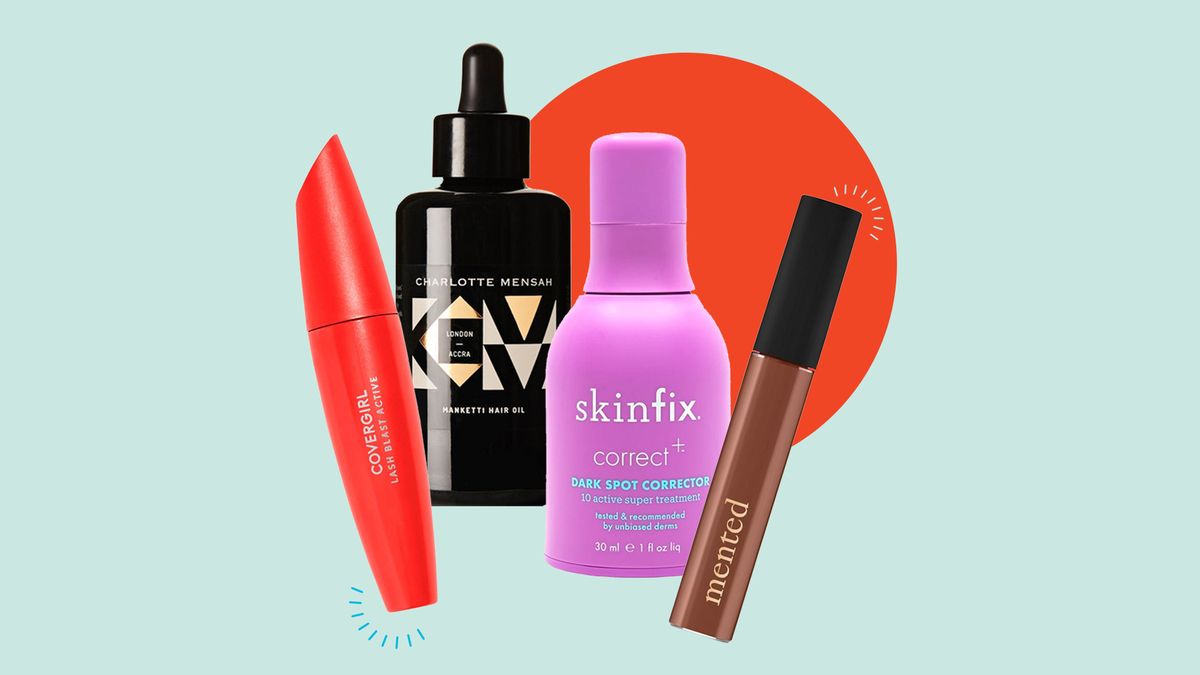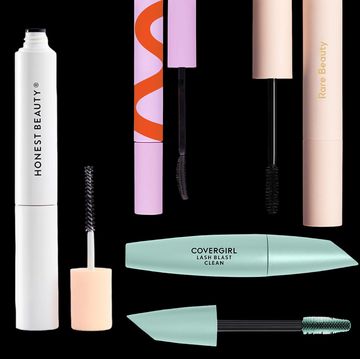If you're curious about veneers, I'm willing to bet that maybe you've got some stubborn tooth discoloration that at-home teeth whiteners or whitening strips aren't helping, oooor maybe you chipped a tooth and finally want it fixed, oooor maybe you're just unhappy with the size and shape of your teeth and wanna get a new smile. Whatever the reason, dental veneers have definitely become more popular than ever over the last few years, thanks to all the teeth transformation photos bombarding us on IG.
But even though the before-and-after photos make veneers look super quick and easy, the process is much more involved (and expensive) than you might think. So if you are interested in the veneer life, let's make sure you're covered on the facts first. And to help us out, I got Michael Apa, DDS, a cosmetic dentist in NYC, LA, and Dubai (he's kiiiind of a big deal, FYI) to break down the different veneer types, the process, the cost, and the commitment, so you don’t run into any surprises down the line.
Why are veneers so popular?
Umm, have you seen the smile transformations (pics below, don't worry)?! Aside from the legitimately surprising results, veneers are also popular for changing the appearance of your smile while still leaving you with realistic and natural-looking teeth. Whether you've got a dental issue, or you just don't like the color of your teeth and want to whiten them permanently, or you have a chipped or broken tooth, veneers can make your teeth look cookie-cutter perfect.
What are veneers?
Basically, a veneer is a thin wafer that is permanently bonded to your tooth to cover its natural color, shape, or positioning in your mouth. You can get a veneer for just one tooth (like if you tripped and fell when you were little, and now your tooth has a gray cast to it), or on multiple teeth. You also have the option to get either get partial veneers (meaning they don't cover your entire tooth), or full veneers (they cover the entire front of your tooth)—it really just depends on your needs and your budget.
Can everyone get veneers?
Although your dentist will make the final call, most people with good oral hygiene and healthy gum tissue can consider veneers if they don't like the look of their teeth or overall smile. Once you've been given the green light (in some cases, orthodontics might be necessary first), you've just gotta decide—with your dentist!—what option would be the best fit for your smile and bank account.
Veneers before and after photos
If you're still a little confused about how veneers actually look IRL, peep a few of Dr. Apa's incredible veneer before-and-after pics below. Since veneers are both an aesthetic procedure and a serious dental procedure, be sure to check out examples of the cosmetic dentist's work to make sure you like their style, but—this is important—also ask for photos of smiles taken years later to see how the dentist's work has held up over time.
What are the different types of veneers?
K, now to really get into it. There are two different types of veneers: porcelain and composite. Let us discuss.
Porcelain veneers
Porcelain veneers are thin layers of porcelain custom-fit and bonded to your teeth. They tend to be stronger, longer-lasting, and better quality than composite veneers (more on that later), buuut also more expensive.
Both types of veneers require multiple trips to the dentist, but porcelain veneers tend to be a bit more involved. First, your dentist will create temporary veneers made out of a liquid composite, almost like a blueprint for your new teeth. The veneers are very stain-resistant, so to find the perfect long-lasting shade, Dr. Apa says he'll looks at a person's skin tone to make a color decision. "I always paint the temporary veneers the shade I'm thinking, so the patient can envision it beforehand," he adds.
Once you commit to your veneer plan and figure out how many you need, your dentist will have you take more molds, X-rays, and photographs. Then, you'll come back to get fitted for temporary veneers and wear them for seven to ten days so you can see how your new smile will look IRL (Dr. Apa refers to this as a "trial smile"). Once you and your dentist agree on what you want, your dentist will take a final set of molds and send them to a ceramist to duplicate. When the porcelain veneers are ready, they'll be fit to your teeth again to make sure they're a perfect match.
Composite veneers
Composite veneers are veneers made from tooth-colored composite resin, which tend to be more affordable than porcelain veneers (but also a little weaker and more prone to staining). For composite veneers, your dentist will use the same material as a dental filling (aka composite) and bind it to your teeth to reshape them. The process requires fewer (but longer) appointments than porcelain veneers, and the final result will rely heavily on the skill of the dentist.
Do they shave your teeth for veneers?
Yes, your teeth might need to be shaved down during the prep stage of veneers, but it really depends on your specific situation. For example, if you come in with large, gray-stained, crooked teeth, your dentist would likely have to shave them down to get the look you want. But if you have, say, short teeth and/or gaps in between your teeth, you won't require as much prep or shaving.
How much do teeth get shaved down?
How much is shaved for veneers also depends on your dentist. For Dr. Apa, for example, "90 percent of the time, I don’t need to shave away more than .5 millimeters to get all of these before and afters you see." (In case you're now reaching for a ruler, 0.5 millimeters is about the thickness of your fingernail—very minimal.) But! That's not necessary true of every dentist, so make sure to clarify with yours first if you're concerned.
Veneers vs. lumineers:
If you've done your fair share of Googling, you might have stumbled across a no-prep version called Lumineers and wondered what the deal is. Lumineers is brand of a specific type of semipermanent veneer and is a potentially more affordable option—emphasis on "potentially," because Lumineers don't last as long as traditional veneers. Lumineers don't require prep (there's no shaving down of the teeth first), but not everyone is a candidate, and not every dentist offers this product, so you'll want to check with your specific dentist first, if you're curious.
What are the disadvantages of veneers?
Lumineers are permanent, but they're not forever. Let me explain. "Bonding cement is a substance that microscopically creates bridges from your real tooth to the porcelain, so the veneer adheres to your tooth and becomes one," Dr. Apa explains. "Think of it as the glue for a press-on nail—only you can’t get this one off once it’s stuck on."
So even though the bond is permanent, porcelain veneers only last for about 15 years, at which point they'll need to be replaced. To replace veneers, your dentist will gently and carefully drill off the old veneer, and start the new process over. See? Permanent, and also temporary.
If you've got commitment issues—or you're going to a dentist you don't fully trust (don't! Do research! Ignore the siren call of Groupon!)—then maybe you should sit this procedure out. Most often, veneers irreversible, because once the tooth is shaved down, it can't be unshaved, and you'll need to continue getting veneers for the rest of your life. The list of the pros can greatly outweigh the cons, but when considering veneers, just be aware that this is a lifelong kinda thing.
Are veneers painful?
At the very least, it's safe to say that veneers are uncomfortable and time-consuming. Depending on how many veneers you're getting, you could be in the chair for hours (10 teeth could take about three hours), and, of course, will require at least a few spaced-out appointments.
Luckily, if you're scared of pain, rest assured that your dentist will numb you with a local anesthetic before starting the veneer process. It's also common for patients to experience dull or sharp pains for a few hours after anesthesia wears off, so consider Ibuprofen your BFF during that time period.
Days after the procedure, there is often an adjustment period where your bite might feel off and you feel zings of pain. If either occurs, your dentist can make slight changes to your teeth with a file (this sounds scarier than it is—dentists do this for regular fillings too) and clear away any excess microscopic pieces of cement stuck between your teeth (which is usually the culprit for any pain). That said, this is all temporary pain. Dr. Apa says that every single one of his patients forgets they’ve had their teeth done because they feel like their natural set after a month or so.
How much do veneers cost?
It all starts with the consultation, which, for Dr. Apa's patients, is $500, but should you decide to move forward with the procedure, the fee goes toward the amount of your overall bill. At Dr. Apa's practice, each veneer, whether it's partial or full, costs $4,000 each, because he's hand-making the initial teeth that are sent to the ceramist to copy.
But at other practices, depending on where you live, porcelain veneers can cost $1,000 to $4,000 per tooth, while composite veneers can cost $300 to $1500 per tooth. Can't swing that very, very large chunk of change? You're not alone. Dr. Apa recommends asking your dentist if he or she offers a payment plan because very few people can shell out that kind of cash all at once.
Do you have to brush veneers?
Now is not the time to retire that electric toothbrush. To keep your veneers looking amazing for the longest possible amount of time, you have to go to the dentist at least twice a year for cleanings and be consistent about brushing and flossing. Veneers are an investment that you have to take care of, just like your natural teeth. If you don't, you'll need to replace them sooner than the standard amount of years.
And guess what? You can still get cavities with veneers, both around the veneer and underneath it. Veneers (whether they fully or partially cover the teeth) are not a set-it-and-forget-it kinda procedure, so again, you'll need to really take care of them to ensure they last as long as possible.
Are veneers worth it?
Every situation is different, so whether veneers are worth it to you depends on how you feel about your current situation, how much money you're willing to spend, and how much of a commitment you want to make. As is the case before any irreversible treatment, talk things over first during a professional consultation to go over the pros and cons of getting veneers so you can fully understand what you're getting yourself into—because veneers are forever (well, kind of).
And hey, depending on what it is you're trying to address, alternative options like orthodontics (braces or Invisalign) or teeth whitening might be good temporary fixes while you decide.















